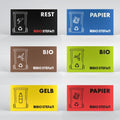Many packages end up directly in residual waste instead of being separated into the yellow bag, yellow bin, organic waste, or waste paper container. This means incineration instead of resource-conserving recycling. This promotes the burden on climate and resources.
Germany as well as Austria are considered so-called waste separation world champions, yet not all materials end up in the designated container. Good waste separation is the first step towards improving recycling; as many packaging wastes as possible should be recycled – for this to work, waste separation must also succeed. But what exactly belongs where? Well-known and generally nothing new: glass in the glass container, paper and cardboard (small format) in the waste paper, packaging in the yellow bag or yellow bin. Less known is that different materials within the disposal cycle should also be separated, for example the metal lid from the yogurt cup, meaning it should be removed beforehand and placed separately in the same yellow bag or yellow bin. Different materials should therefore not be stuffed into each other.³
Waste rules are constantly changing, partly because there are regional or local differences in waste separation. In Austria, for example, collection varies greatly. This is set to change as of 1.1.2023, with a uniform recycling regulation now in place. Now "more" plastic waste is allowed in the respective yellow bags or yellow bins. A "collection increase" of 20% compared to the previous year is expected here.1.
What is allowed in now? Common packaging materials like yogurt cups, juice cartons, plastic trays for vegetables, fruit, pet food, and packaging for sliced cheese as well as sausage. PET bottles, shower gel containers, and many more.
ATTENTION: Large packaging materials such as films or styrofoam from packaging should still be taken to the recycling center.
Even light metals like aluminum or tin cans can be collected in Vienna in the yellow sack or yellow bin. However, this regulation applies to all of Austria only from 2025.
What about Germany? In Hanover, for example, the switch to yellow bins will be nationwide from January 1, 2023². The yellow sack is thus obsolete. This improves cleanliness in the city and prevents situations with blown-away or torn sacks and the resulting scattered waste components, which lie around, cause annoyance, and incur additional cleaning costs.
But what are the advantages of the yellow bin compared to the yellow sack? With a uniform system, waste collections can work more effectively and cost-efficiently. This saves plastic waste that was previously generated by 35 million plastic bags annually. This amounts to 700 tons of plastic material that thus burdens the environment less. For residents, the yellow bin is free of charge.
Which bin size is the right one now?
The common sizes are 120 and 240 liters; the transition for individual households began as early as November 2022. But which bin size do I need or is right for our household? Simply put, you calculate with 15 liters of waste per person per week, so a 120-liter bin is just right if the household has a maximum of 4 people. From the fifth resident, 240-liter bins are delivered; in multi-family houses with 20 registered people or more, there are 1100-liter containers.
You will definitely find the right bin enclosures at BIO Stefan. Whether it is a 120l or 240l bin, we offer the right solution.
THE practically robust bin enclosure without any frills in the solo version for 240l containers (e.g., paper recycling bins).
For our nature-loving customers and wood enthusiasts, we have the wooden bin box - Holzmichl by BIO Stefan® in our range.
THE naturally robust and flexible lockable bin enclosure in three versions
With REAL wood cladding suitable for your 120l and 240l containers. Click through to Holzmichl and the available variants.
This post was lovingly created by the Bizibits social media marketing team. Visit us at www.bizibits.com, to explore our website.
- https://www.heute.at/s/diese-neuen-muell-regeln-gelten-in-oesterreich-ab-112023-100246033
- https://www.zak.de/Nachrichten/Muelltrennung-ist-ausbaufaehig-154107.html




